Description and Summary:
"Recent Sleep Works" - Glossolalia - ResonanceFM 104.4 Radio program 2010
Download
Early Sleep Works:
1-"N1-N4 Variations (Vocal Documentation From All Four Sleep Stages)" - CD-R / SUT 2008
BRYAN LEWIS SAUNDERS - N1-N4 VARIATIONS (CDR by Stand-Up Tragedy Records)
One of the stranger items I've had to review, although I forgot which issue, was the 'Experiments With Dreams' by Thomas Liljenberg and Leif Elggren, a book about dreams and CD with the sound of two people sleeping. Hardly a surprise that the same Elggren suggested one Bryan Lewis Saunders to release his 'N1-N4 Variations' - 'a vocal documentation from all 4 sleep stages'. Fifteen pieces in total of this. It started out with recordings of his dreams when he was awake, but he decided to create while dreaming and talking in his sleep. Certainly as strange as the Elggren/Liljenberg release, but not snoring sounds, but unconscious talking. Not always easy to follow what he is saying, but surely 'strange' enough. Maybe its a bit long at fifteen 'tracks' that all sound quite similar but its surely something to use when having guests at the dinner table - even when this is released in an edition of 20 copies only.
Frans de Waard: Vital Weekly 639
2-"Animus Chora (Spirit Recptacle)" - Podcast / Belsona Academy 2009
3-"87 Dreams of a Sociopath" - Album & Book / Surrism Phonoethics 2010
Download
4-"Le Bobcat" Raymond Dijkstra & Bryan Lewis Saunders - Cassette / Fragment Factoory 2010
Download
5-"Hopi Torvald & Bryan Lewis Saunders Split" - EP / Hopi Torvald 2010
Download
Stream of Unconsciousness (Narrative Mode):
For the last 7 years or so I've been recording my dreams and sleep talking on audio cassette. I call the transcriptions of this dialog, the "stream of unconsciousness (narrative mode)" method of writing as I don't remember having said any of it once I awake. It is all from my unconscious. Some of my friends from around the world have made music with my dreams. These dreams have been combined to form an epic poem. Aptly titled, "The Confessor". "The Confessor" is now an 11 hour book on tape with 24 album/chapters, and the box set is due to be released fall 2013 on Stand-Up Tragedy Records. The book itself will follow and is composed of 30 poem/chapters from 30 nights sleep. Written exactly as spoken in my sleep.
The Albums:
1-"Replicate" by Hopi Torvald
2-"Red Bugs" by Kommissar Hjuler und Frau
3-"The Confessor" by Razen
4-"I Pickle All Enemies" by Ad Beentjes, Anton Mobin, Murmurists, Thomas Fernier, undRess Béton
5-"Cocaine House" by Evil Moisture
6-"Life is a Runaway Semi-Truck" by Wehwalt
7-"The Severed Head" by Love Execution Style
8-"Squirrel Party at Sally Fields" by Adam Bohman and Adrian Northover
9-"White Surrealist Nihilismus" by Yoshihiro Kikuchi
10-"Dolphins Revenge" by Christopher Fleeger
11-"Michael Moore's Snuff Film" by Sinus Buds
12-"Torso" by Andy Ortmann
13-"French Spies" by Sudden Infant
14-"It's Parents Like You That Are Flies On The Horse's Face" by Dylan Nyoukis
15-"Identity Technology" by Lee Gamble
16-"N2" by C.M. von Hausswolff
17-"Double Sleep" by Leif Elggren
18-"Pyro" by John Moloney
19-"Dream Vacations" by Language of Light
20-"Psycho-Drama" by Matthew Reis
21-"Crazy Is Special You Are For One" by Offerings
22-"The Weaver Box" by Requiem
23-"Your Excellency" by Hopek Quirin
24-"White-Flag-Flagpole" by Fantom Auditory Operations (Michael Esposito)
ALBUM COVERS, PRESS AND REVIEWS
Art/Design by Alice Salyer
VOLUME 1-12:

Volume 1 (with 9 page booklet of text)
Side A: Hopi Torvald "Replicate"
Side B: Kommissar Hjuler und Frau "Red Bugs"
Round-up Rotary Rogues
No less unsettling are the Streams Of Unconscious tapes sent to us by the American writer and performance artist Bryan Lewis Saunders. Three volumes I know of so far; the first is Replicate, a collaboration with Hopi Torvald, and Kommissar Hjuler and his wife with Red Bugs. Saunders has been documenting his sleep-talking and dream states for many years, even recording his own sleep-talking on tape. For this series of projects, he sends out the tapes to musicians and sound-artists to refashion them as they will. Torvald creates a suitably ambiguous tapestry of nightmarish ambient music, whose very disjunctiveness does its level best to follow the twists of Saunders’ mind. For this side of the tape, Saunders’ continual mumbling becomes one more element in the mix, and the overall effect will gradually unhinge your mind. Full transcriptions of the sleep-raps are included inside little printed booklets with the releases. The Kommissar Hjuler side is quite different, looping and repeating a single short phrase of the sleep-talking as the basis for an invented song, a dark nursery-rhyme plucked from the deepest recesses of the brain. The endless repetition of ‘objects…supernatural’ will probably send you to the bughouse in short order, but since Hjuler is a Dadaist nutcase of the first water anyway (and I sincerely mean that as a compliment) he is a perfect candidate for a marginal aural experiment of this nature. Also pictured, not yet heard: Volume 2 with Razen and Classwar Karaoke Friends, and Volume 3 with Evil Moisture and Wehwalt. If you’re a fan of the record Dion McGregor Dreams Again, prepare for something so powerfully odd that McGregor will soon seem positively quaint and charming in comparison. Ed Pinsent
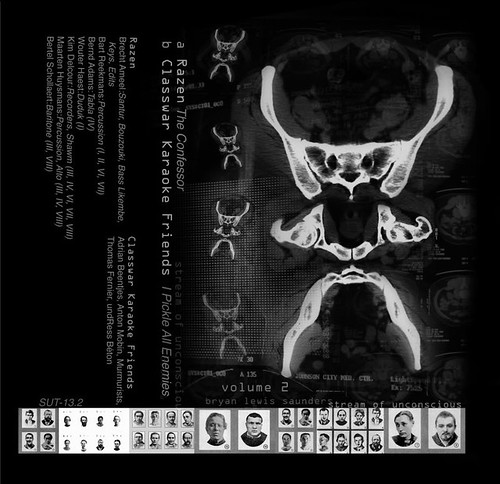
Volume 2 (with 25 page booklet of text)
Side A: Razen "The Confessor"
Side B: Classwar Karaoke Friends "I Pickle All Enemies"
Bryan Lewis Saunders with Razen and Classwar Karaoke Friends
Stream of Unconscious Volume 2
(Stand-Up Tragedy Records)
Chattanooga Pulse
Visual and spoken-word artist Bryan Lewis Saunders, from Johnson City, Tenn., is known for his visceral, brutally frank and often disturbing outpourings, of which there seems to be an endless supply. For example, 16 years ago, he began to create at least one unique self-portrait every single day—a routine he intends to keep until death, having made more than 8,000 of them so far. He’s so good at it, one might say he could do it in his sleep.
Actually, he does create art in his sleep—he tape-records his dreams and sleep talking, coming up with bizarre stories. It’s kind of like the “automatic writing” method of surrealists such as André Breton in the early 20th century, but instead of merely tapping into the subconscious, Saunders is on a different level by harnessing the unconscious.
Saunders’s latest audio work is an ambitious project entitled Stream of Unconscious (Narrative Mode); when completed, it will consist of twelve cassettes, each side of which serves as a separate chapter with a collaboration with a different avant-garde sound artist or group. The second volume features “The Confessor” with the Belgian group Razen and “I Pickle All Enemies” with the experimental music collective Classwar Karaoke Friends.
Saunders’s stories are sometimes impenetrable ramblings, mentioning burgers with secret names or using odd lines like “Pigs are always hungry so juicify them.” At other times, he manages to tell semi-comprehensible stories of impersonating lawyers or a “torture and pickling process.”
Razen uses exotic instrumentation from faraway lands, such as the lute-like bouzouki, obscure wind instruments, a variety of percussion, and the santur, a type of hammered dulcimer. Classwar Karaoke Friends takes a technologically minded approach, slicing and dicing and manipulating Saunders’s speech and providing electronic molestations and low, foreboding rumbles.
If there’s one word to describe Saunders’s monologues, it would be “unsettling,” and the soundtracks complement the disorienting mood. While Razen places the listener in foreign, unfamiliar lands, Classwar Karaoke Friends puts him in a state of uneasiness. - Ernie Paik
Sleep Works
La rencontre avec Bryan Lewis Saunders s'est faite grâce à Colin Johnco en mai 2010 au studio Black Byzance (Paris) pour une session d'enregistrement intitulée "Saut dans le vide" avec Elisa Point (voix-texte), Frédéric D. Oberland (guitare, harmonia), Colin Johnco (électronique), Bryan Lewis Saunders (voix-texte) et moi-même (objets).
Les jours qui suivaient, j'invitais Colin et Bryan pour l'une des plus belle "Maïzing session" (#13 ) sur la webradio KKWNE , pendant laquelle l'expérimentation fut de mise avec Colin à la guitare drônante, Bryan effectuant une lecture éveillée de son livre 'The reasons why i dream with knives " et moi disséquant un disque vinyle aux couteaux...
Par la suite, je participe aux compilations en ligne "Classwar Karaoke " sur l'invitation de Adrian Beentjes, Anthony Donovan et Jaan Patterson. Compilations dans lesquelles figurent également Bryan et Colin depuis le début.
Avec Bryan, nous participons en duo au projet d'Hal McGee "IEAAP". Je reçois un texte endormi de la part de Bryan que je met en son pour le volume 5 Download Instructions " ; qui est à mon sens ma plus belle pièce parmi mes 26 propositions pour ce projet. du projet, titre"
Voilà, l'historique est fait !
Tout ça pour ne pas dire grand-chose, si ce n'est l'attachement et la sympathie que je ressent pour Bryan et les amis de Classwar Karaoke. Bryan Lewis Saunders est un poète de la nuit, dans le sens où ces enregistrements vocaux y sont faits dans un état second, proche de la somniloquie ou tout du moins très assoupi. Morphée dans tous ses états joue avec le verbe pour nous conter la douleur, l'ambiguïté et la fragilité d'un artiste émouvant. C'est un gran honneur de participer au projet "Stream of Unconscious" de Mr Bryan Lewis Saunders!
Anton Mobin
Razen: The Science of Sleep
‘The Confessor ’ is a collaboration between free ethno psych band Razen and conceptual artist Bryan Lewis Sanders. Sanders delivers the vocals, Razen is responsible for the music. Sanders recorded his vocals while being asleep, which is part of his ambitious Stream Of Unconscious serie. Razen’s Brecht Ameel explains.
I only knew Bryan Lewis Sanders from his drug portraits. How did you get to know his work and how did you get in contact with him?
Initially, I contacted Bryan as a fan. I had discovered his music on one of the WFMU shows and I had been struck by how his use of voice and his narration had a very distinctive tone and created an immediate poetic spell. Later on I read an interview where he mentioned his disillusion of making it big as a stand-up comedian in China. He seemed to be a person who’s looking for the extremes, both in his personal experiences and in his artistic output. I see that as a positive trait. I should often be more like that myself. So I wrote him a sort of fan note and after a while he sent me a four or five hour sleep recording to work with.
Did you meet Bryan for this collaboration?
We haven’t met in person yet. I hope we will. It would be great to run into each other once while touring and be able to do a show together, have a shared momentum onstage.
How did you work together on ‘The Confessor’ than?
I cut the original sleeptalk recording into various shorter pieces and I worked our music around it. It was simply a matter of sending files through the net. I was able to approach the material without any forced direction. Bryan let me run wild with it.
This release is part of Saunders’ Stream Of Unconscious series. Can you explain the concept behind this series and behind this record?
Well, it’s a massive enterprise, to say the least. Bryan has been recording himself while talking in his sleep for quite some time now. He refers to this sleeptalking as his stream of unconscious method of writing. There are 24 so called sleeptalk sessions that form the chapters of his unconscious novella, each with a different artist doing the music.
Bryan’s novella as a whole will be released in the form of twelve separate split tapes, text included, and as a box set with all the tapes and a book. I should mention that the artwork by Alice Lane is fantastic too.
Where does the title ‘The Confessor’ refer to?
I think there are a number of possible answers. ‘The Confessor ’ might be the narrator, Bryan’s persona while unconscious or dreaming. Or he might be the person recording the dream, the character that’s introduced in the first part, who’s eliciting people’s confessions… There are quite a number of possible entries into the narrative. In the beginning of the project, I saw the narrator as a triple-agent stuck in an Afghan hideout, troubled by nightmares, paranoid and ranting on in his audio diary… But after all it’s a dream, illogical and layered, it’s Bryan talking in his sleep, in between snoring and dozing off.
This album is released as a tape. Does the object of a tape have a special meaning for you?
For sure the audio nature of tape adds an extra layer to this release.
The hiss of Bryan’s original recording was quite strong and I tried to use that as a coloring in the edit. There’s a timeless quality because of the tape. And personally I enjoy playing tapes. I still have an 80s Walkman, one with a tiny built-in speaker. I don’t have a car radio anymore and I am always listening to tapes on the Walkman, that I keep lying on the passenger seat. A lot of music is rendered truly manic and possessed by that device.
Razen sounds different on this record than on the previous one. More open and free. Why is that, you think?
The first reason I believe is length: on the Kraak record, we wanted to compress as much of our world as possible into four songs. Each track had to mark out it’s own territory. Now it’s almost an hour of music that is meant to be listened to as a whole. Another possible reason is that having the voice somewhat up front and the music as a conduit for the story creates a certain freedom. I wanted Bryan’s voice to be the center of attention, not the music. Because that voice disappears every now and then, or turns inaudible, there is a sense of floating, … you could say it’s, well, dreamlike.
The music of Razen reminds me of a lot of things on this album. It reminds me of Godspeed when you combine spoken word with dark acoustic soundscapes. Of Af Ursin when every whisper sounds like poetry, of Radian when each click sounds in place, of Lounge Lizards when it sounds nonchalant cool.
Those are all great references and I have been listening to those bands at certain times. So surely they will be of influence somehow. I would say that William Burroughs in Tangiers was a personal reference for me in the light of this album, maybe an obvious one. Also some Mirror recordings have been very influential of late, as is the cinematic approach of Kato Hideki.
And then there’s the influence of Morricone when your music comes close to kitsch. Are you aware of that?
You can’t be doing instrumental music that’s somehow story-driven and not be influenced by Morricone… As for the kitsch, I would say that with our instrumentation there just is a direct transfer of emotion. Maybe that’s why you’re mentioning Morricone; in some of his music, he’s using obvious statements, underlining what’s happening with a broad gesture. He’s in a league of his own, of course. In our case, I would say that you simply couldn’t have a fading sense of suggestion on bagpipes or shawm. Those instruments just have too powerful a presence. The recorder, then, has the ability to sound human in a way people feel too sophisticated to submit to, nowadays.
With every release and at almost every concert, the line-up of Razen changes. Does this mean that you are still looking for a definitive line-up?
Razen isn’t really a band but an idea, of which you might say that I am the initiator. And it’s not easy to find the right people to complement that idea, both on a musical and a mental level. Since the past six months we’re a duo, consisting of Kim Delcour on bagpipes, shawm and all recorders, and myself on santur, bombus, psaltery and bouzouki. Having to generate the same power and sense of orchestration just with the two of us has been very challenging, especially in a live situation. I believe the music benefits from that tension, so we’ll keep working as a duo. But in the past months we also met some great instrumentalists that are ready to join the frenzy.
There has been two Razen release until now. Both of them were split records. Are you working on the first Razen full album?
Yes, in our minds we are working on a first full album. There is a lot of new material that we developed by playing live. What we do is still largely improvised but our method has changed: we now focus on a single image or a single note. Which has taken us into a wholly other realm, one that has more to do with pre-industrial and spectral music than ethnic psych. We still have to capture the material in a way that’s interesting for a listener, though.
Besides being part of Razen, you’re also a solo artist. Does the music of Razen have an influence on your solo work? And does your solo work have an influence on Razen?
Razen is all about my love and curiosity for certain instruments and the attempt to construct an imaginary world of primitive tone by using those instruments and by improvising in duo or ensemble settings. In my solo work the instrumentation is a lot more conventional and the focus turns toward composition and studio work. Also I don’t shy away from my conservatory training, while with Razen, I want to block off all technical matters. The passion for acoustics and natural resonances is identical however.
Bryan Lewis Saunders
Razen

Volume 3 (with 8 page booklet of text)
Side A: Evil Moisture "Cocaine House"
Side B: Wehwalt "Life is a Runaway Semi-Truck"
Volumes 3-5
The series now continues with three new volumes. Evil Moisture stays closely to the original voice recordings, which he sometimes reverses, and adds tiny bits of vinyl manipulation to it. Its very minimal but its has great creepy texture to it. Not a piece of noise, which I perhaps inaccurately expected. On the other side we find Wehwalt of whom I never heard. They (?) too let the source material prevail but add more sounds to it. Sounds of an electro-acoustic nature, banging on objects, rumbling around the house, at night, in the dark, with electrical currents occasionally sparking - i.e.. feedback sounds. Music however takes over in the second half and things become very hallucinating and psychedelic. Actually some great music here: a multi-layered nightmare of sounds. The true stream of unconscious mixing of sounds.
Also I never heard of Love, Execution Style from Chattanooga, Tennessee, who add a more filmic soundtrack to the music. Its not easy to say what the hell they are doing, but they add a nice radiophonic aspect to the Saunders source material. Its quite captivating. Which can also be said of the other side, which has music by Adam Bohman (best known of Morphogenesis and Bohman Brothers) and saxophone player Adrian Northover. Their improvised music on saxophone and voice (Bohman repeating words from Saunders I think) works very well, but is perhaps a bit too long for my taste. Its basically one idea and at that a bit too long.
The fifth volume has two artists I never heard of, Yoshiro Kikuchi and Christopher Fleeger. Kukuchi uses electronics, percussion, composing, editing and mixing on an old computer abuse. Music plays an important role here and the voice is manipulated too. The music once again takes the form of a stream of unconscious mixing, but this time of all electronic sources. Quite chaotic but the slow whispering voice of Saunders seems to balance this work quite well. Here too however I think it was all a bit long. Fleeger solely seems to be working with field recordings, which add a spooky character to the music. From the six new sides this I thought was the best. - Frans de Waard, Vital Weekly 828
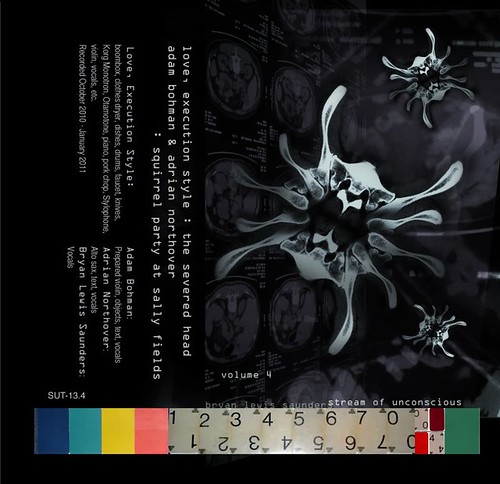
Volume 4 (with 12 page booklet of text)
Side A: Love, Execution Style "The Severed Head"
Side B: Adam Bohman & Adrian Northover "Squirrel Party at Sally Fields"
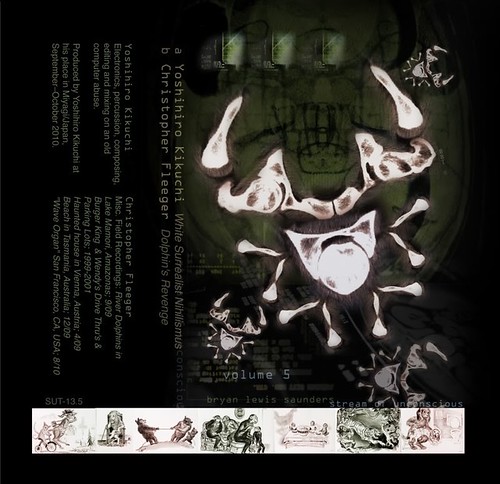
Volume 5 (with 21 page booklet of text)
Side A: Yoshihiro Kikuchi "White Surrealist Nihilismus"
Side B: Christopher Fleeger "Revenge of the Dolphins"
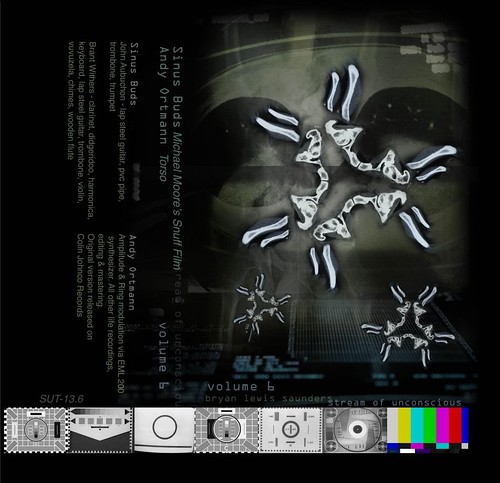
Volume 6 (with 9 page booklet of text)
Side A: Sinus Buds "Michael Moore's Snuff Film"
Side B: Andy Ortmann "Torso"
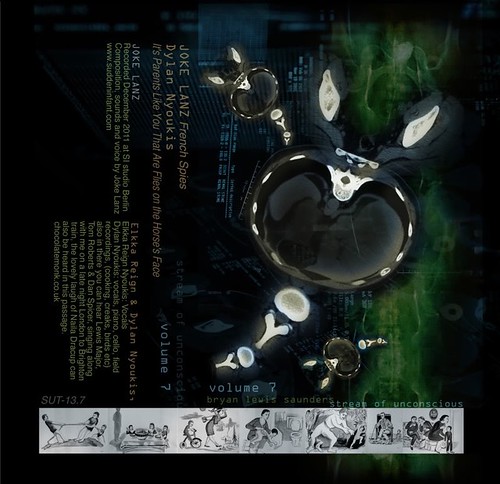
Volume 7 (with 14 page booklet of text)
Side A: Joke Lanz "French Spies"
Side B: Dylan Nyoukis "It's Parents Like You that are Flies on the Horses Face"
Volume 7
JOKE LANZ/DYLAN NYOUKIS -STREAM OF UNCONSCIOUS VOL. 7 (cassette by Stand-Up Tragedy Records)
Hot on the heels of the previous three in this series of twelve, here are two new additions to the Bryan Lewis Saunders 'stream of unconscious' series, where he sends out tapes of himself talking in his sleep to be put to music and a split release of two artists working on it. On the first tape we have Sudden Infant's Joke Lanz and Dylan Nyoukis. It might not be true, but it seems if Lanz re-recorded the voice of Lewis himself and uses that as a guidance for his piece, which is quite good, less noisy than one would perhaps expect (but his recent solo CD also hinted in that direction). A strong electro-acoustic radio play like piece, which goes almost without interruption or stylistic change over in the piece by Dylan Nyoukis. He lists a bunch of things he uses (piano, cello, field recordings) and a bunch of other voices, and his piece grows effectively into a strange affair of rambling voices and the sleeping Saunders tape. An interesting form of dementia seems to be leaping in here. (FdW) Vital Weekly #837
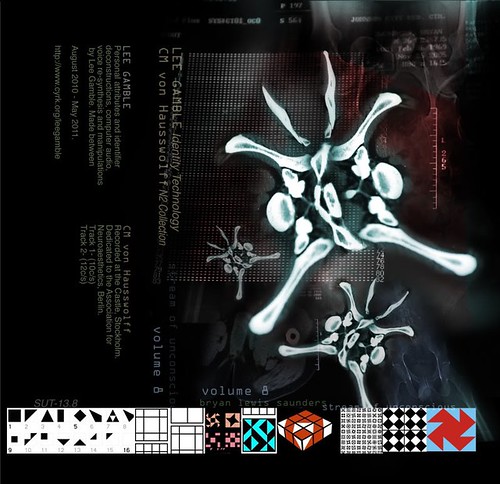
Volume 8 (with 6 page booklet of text)
Side A: Lee Gamble "Identity Technology"
Side B: CM von Hausswolff "N2 Collection"
Volume 8
LEE GAMBLE/CM VON HAUSWOLFF - STREAM OF UNCONSCIOUS VOL. 8 (cassette by Stand-Up Tragedy Records)
The other tape is a bit shorter, twenty minutes per side and has Lee Gamble, who is a member of the CYRK collective and has some releases on Entr'acte. His side mentions 'personal attributes and identifier, deconstructions, computer audio, voice re-synthesis and manipulations', which perhaps doesn't make things much clearer. He does something highly obscure with the source material, and I can't figure out what it is. Not that is perhaps that important to know what it is, because it sounds very nice. It seems as if he fades the mumbling through some sound effects and somehow it sounds like he was half asleep himself. That may sound negative, but I mean this very positive. Excellent obscurity. Hauswolff on the other side mentions just the recording location, and does what he always does: extreme tone material, of loud, short repeating sounds with the voice of Lewis somewhere in there too, but seemingly unprocessed. I am not sure if this was a lot of work, or rather an in between job, but just for the fact that this is an entirely different approach, makes it for me quite enjoyable. (FdW) Vital Weekly #837
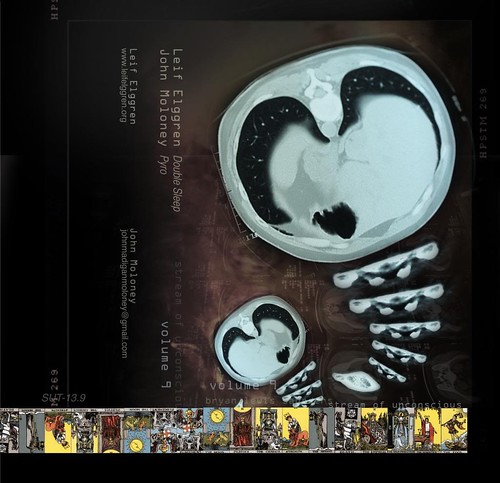
Volume 9 (with 6 page booklet of text)
Side A: Leif Elggren "Double Sleep"
Side B: John Moloney "Pyro"
Volume 9
Sound poetry, but of a different kind is by Bryan Lewis Saunders, who records his dreams and sends these out for 're-mix' by others. Volume 9 had a copying error, otherwise it would have also been in Vital Weekly 873. Leif Elggren is no stranger to the land of sleep and dreams, having already done a book and CD 'Zzzz'. His approach is surely the most conceptual for this series. In one channel we hear Saunders' dreams and sleep sounds, while Elggren is vast asleep in the other channel. Maybe, or maybe not, there is an element of 'processing' his sleep sounds, but that is wide open for debate, I think. Moloney is from the 'big Dayton noise scene' and uses mainly voice but here also the field recordings of a fire. Saunders' dream recording seems mostly absent here, oddly enough. Splitting channels seems to be a favorite here too, and there is actually most of the time no voice to be detected here, and the fire recordings are a bit treated so it sounds like rain on a barrel. Quite interesting sound wise, although highly minimal with slow changing sounds, this seems all rather far fetched from the world of Saunders and his captured dreams. This volume is indeed one of the stranger ones from the series so far. (FdW) Vital Weekly 875
Side A
EXTENDED HONEYMOON – A Work by Leif Elggren a day... Part Twenty-Five: Stream of Unconscious, Volume 9 / Double Sleep | The Cut-up Method – King Leif's contribution to The Stream of Unconscious project, a single, united, unified literary and sound art work by Bryan Lewis Saunders, comprising 24 albums on 12 cassettes. Each album is a single chapter in Saunders' novel (The Confessor), written in an écriture automatique-like fashion, unconscious, transcribing dream descriptions and somniloquy. Saunders records his sleep and dream talking, on tape (would be awesome to hear the originals, maybe one for The Tapeworm?). He then transcribes the recordings. He has no recollection of what he has said during his sleep and dream. Recordings and notations are the only remainders. And memento. Combined with the sounds on the tapes, these words project an image of an epic poem, or: libretto for a dream and sleep opera of some sort – wholly unconscious, at least: this begs the question as to how (un)consciouss the sound artists were when they worked with the original input material from Saunders... From Zzz... to In Sleep the Knives Are Sharpened and of course the Sleepwalking tape; in fact: in numerous other releases and works too, King Leif has addressed sleep and dream and actively engaged with the borderline between waking and sleeping; transgression the mental and physical crossing of the states, plus the deprivation of sleep – i.e in 10 days- An Expedition (1981). Writing down his dreams since age fourteen, King Leif “has always hated the night”, being a bad sleeper, and a great dreamer, he “has to wake up all the time to make sure he's still alive”. This is at the heart of King Leif's body of work. His art task, so to speak. This is the motor behind his creative effort. King Leif's art is centered upon this mission. His “[a]rt is disengaged from this and functions as a kind of nourishment for people to find something in their lives. Both for the practitioner and the viewer. Art is a tool with which to achieve an individual truth, it tells us how we must live our lives. Art should be congruous with the task one is born to.” Born to become angels. And keep going. Wake. Sleep. Dream. In Double Sleep recurring motifs and dreams present in King Leif's work return. Elements like food and taste (ref. smell); cut-up method, memories, writing and reading and a continuous ground hum noise floor level of short circuiting sparks and plugs, machine rumble(s) and (natural) breathing; sleepwalking, also? But – now through the unconscious and inner voices and voicings of Saunders and his bed room sleep (field) recordings. This is one channel. On the other channel we hear King Leif vast asleep; the virtually unprocessed sound of sleeping. Again: a double sleep, like the performance King Leif did with Thomas Liljenberg in Groningen, The Netherlands (14 days of sleeping and dreaming, Metro Gallery, 1982) of which Zzz... is the remainder and memento; the manifestation post factum. Two men sleeping. And no cutting-up. Two men dreaming. And recording. Evoking the concept and ideas, the very notion of continuous recording, the always being at work, considering waking, sleeping, dreaming to be the task at hand. And: the main focus. The content in and of itself. The matter, the stern stuff. High pitched sounds, snoring, creaking of bed spring (?)... Never static, always evolving, progressing, lengthening, quickening, breathing, sighing; intimate and far from stripped down minimal... Up close and personal; constant flux. The sound of dreaming projected: either written down or recorded matter of factly. The matter, the stern stuff. Of factly. Factly. Yes! And: a meditation on the strange sensation of being intimate witness to this double sleep. Shouldn't you be asleep? And dream, too? Are you awake?! Are you sure? Is reality the dream state maybe? Is reality's speech the cut-up method maybe? How conscious are you, are we? A blur. An experiment with dream and sleep. The double sleep as a metaphoric representation and recording of double dream? And exploration of the internal and mental through the external and physical?! Like evoking Poe's spirit by rocking and recording his original (or is it, even?) rocking chair? Or did it? Poetically, maybe? No word play pun intended, or maybe it is. Still: also matter of factly. Hidden poetry for all to hear. For all to fear? Or join? Sleep has its houses. :))) --- [Limited edition cassette, clear blue shell, color printed j-card, with mini-booklet featuring the words/lyrics, C90 split tape with John Moloney, released by Stand-up Tragedy Records in an edition of 80 copies] - Sven Schlijper-Karssenberg
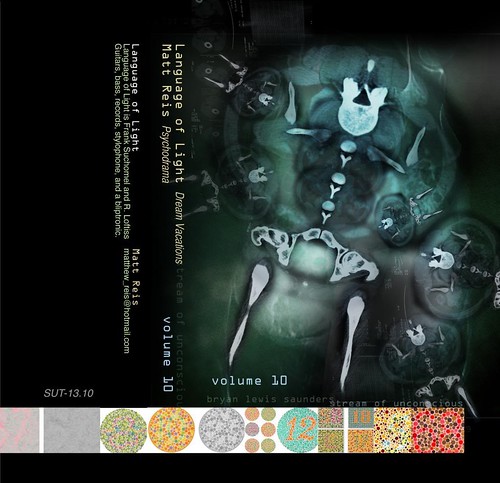
Volume 10 (with 18 page booklet of text)
Side A: Language of Light "Dream Vacations"
Side B: Matt Reis "Psychodrama"
Volume 10
Bryan Lewis Saunders with Language of Light and Matt Reis: Stream of Unconscious Volume 10 (Stand-Up Tragedy):
"With a Go big or go home"; artistic dedication, the wildly creative, often disturbing, Johnson City-based spoken-word and visual artist Bryan Lewis Saunders is approaching the end of his 12-volumeStream of Unconscious project.
Saunders gained infamy in recent years for his series of self-portraits, each created under the influence of a different controlled substance, and part of his commitment to make at least one self-portrait every day of his life, until death—upheld since 1995. However, his audio recordings are equally worthy of attention, and the idea behind Stream of Unconscious is to take Saunders’s recordings of him narrating his dreams as they occur and putting them in the hands of 24 different avant-garde recording artists, each taking one side of a cassette.
The music of the Oklahoma duo Language of Light has a deviously pervasive approach, never quite falling squarely into either the “melodic” or “noise/drone” camp. Some bass and guitar motifs approach more conventional structures, but are subverted by periodic guitar skronks. Chimpy keyboard patterns frolic with strings and hard-to-place synthetics. “Royal Abortion” uses a recording of march music while Saunders describes British soldiers “with bayonets and rifles all poking” at him, and perhaps the most unsettling story is the brief “Lost Luggage,” which uses the playroom-sounds of a music box while Saunders mumbles, “No more lost luggage, uncomfortable dreams, miscarriages.”
Matt Reis generates an odd strata of disquieting ambient layers under Saunders’s dizzy and delirious ramblings about everything from a convenience store encounter to an alcoholic stalker to nuclear weapons. The most startling moment comes with a revelatory tension release after some of Reis’s particularly awkward noises, contrasted with the near-silence of tape hiss and the sounds of Saunders squirming.
Reis then concentrates on various drones, possibly made from vibrating metal, and the album ends abruptly, with Saunders muttering, “I just said good to everything. Good … good … good.”
That’s the deceptive unconscious reassurance in his nightmare world. - Ernie Paik (Chattanooga Pulse)
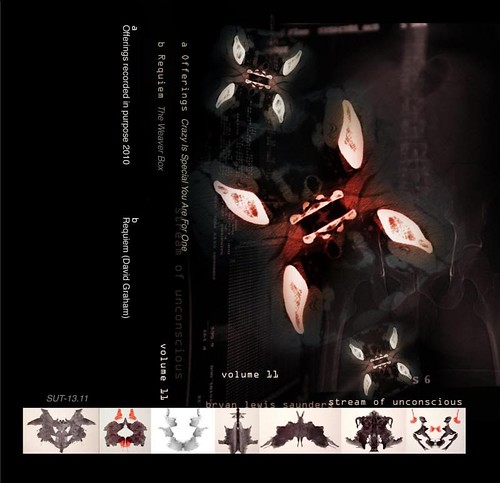
Volume 11 (with 8 page booklet of text)
Side A: Offerings "Crazy Is Special You Are For One"
Side B: Requiem "The Weaver Box"
Volume 11
We start with volume 11, which has Offerings and Requiem. The first only says 'recorded in purpose 2010' and for the side of Requiem we see (David Graham), we is, on both accounts not a lot to go by. Musically they are wide apart. Offerings create one loop of involving a drum machine, some synth sounds and a sequence, and the Saunders dream material is pushed towards the back, most of the time. It doesn't sound like dream/sleep material, but that's perhaps because of the somewhat more industrialized soundtrack that is on offer here. It sounds like one of those throw away early Throbbing Gristle loops, and genuinely retro, but quite nice at such. It's indeed something entirely different than what Requiem is doing on the other side. Here we have something that sounds like amplified hiss from the background, very quiet and a bit drone like, in which the voice of Saunders is very nicely embedded. This is the piece I actually liked best, but perhaps its also the more predictable one? (FdW) Vital Weekly 888

Volume 12 (with 8 page booklet of text)
Side A: Hopek Quirin "Your Excellency"
Side B: Fantom Auditory Operations "White-Flag-Flagpole"
Volume 12
Hopek Quirin 'played bass, guitar and knives'. He plays these in a rather improvising mood, I think, but he also plays them very sparsely. If you do hear them, they might have the shape of a small humble drone. Saunders' voice plays a more important role than the music here, so it seems, which is a pity - it could have been more in balance, I should think. It makes it all a bit too obscure for my taste. Fantom Auditory Operations are Michael Esposito and Bryan Lewis Saunders. Ah that explains. Esposito (see also elsewhere) is a master of recording speech that 'is not quite there'm voices from beyond, the so-called EVP. This is actually quite an obscure side, maybe the most obscure of the whole series, partly because it seems nothing else is going here than just Lewis his voice and maybe a bit of a sound processing, but we can't be too sure about it. Partly its perhaps because its not easy to hear what the voices are about. Quite mysterious all together, and perhaps obscure to, but this is a totally different kind of obscurity. Here we don't know any better and music is absent, so that's what it is. These twelve volumes have been a most strange journey through some odd nocturnal activity. Many highs, few lows, usually just great. (FdW) Vital Weekly 888











